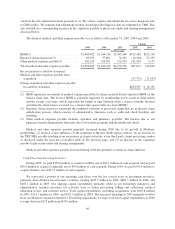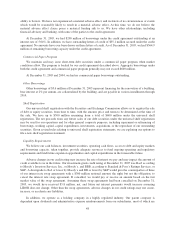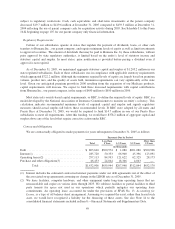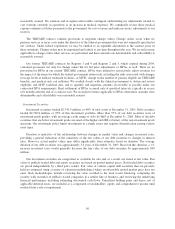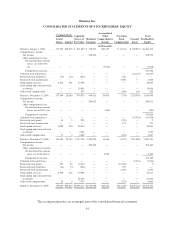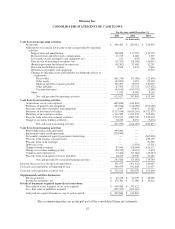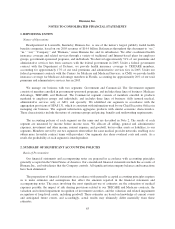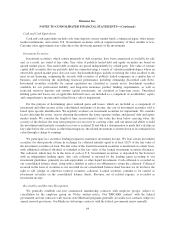Humana 2005 Annual Report Download - page 66
Download and view the complete annual report
Please find page 66 of the 2005 Humana annual report below. You can navigate through the pages in the report by either clicking on the pages listed below, or by using the keyword search tool below to find specific information within the annual report.reasonably assured. We estimate and recognize unfavorable contingent underwriting fee adjustments related to
cost overruns currently in operations as an increase in medical expenses. We continually review these medical
expense estimates of future payments to the government for cost overruns and make necessary adjustments to our
reserves.
The TRICARE contract contains provisions to negotiate change orders. Change orders occur when we
perform services or incur costs under the directive of the federal government that were not originally specified in
our contract. Under federal regulations we may be entitled to an equitable adjustment to the contract price in
these situations. Change orders may be negotiated and settled at any time throughout the year. We record revenue
applicable to change orders when services are performed and these amounts are determinable and collectibility is
reasonably assured.
Our former TRICARE contracts for Regions 3 and 4 and Regions 2 and 5, which expired during 2004,
contained provisions not only for change orders but for bid price adjustments, or BPAs, as well. There are no
provisions for BPAs in our current TRICARE contract. BPAs were utilized to retroactively adjust revenues for
the impact of the items for which the federal government retains risk, including the risks associated with changes
in usage levels at military treatment facilities, or MTFs, change in the number of persons eligible for TRICARE
benefits, and medical unit cost inflation. We worked closely with the federal government to obtain and review
eligibility and MTF workload data, and to quantify and negotiate amounts recoverable or payable under our
contractual BPA requirements. Final settlement of BPAs occurred only at specified intervals, typically in excess
of 6 months after the end of a contract year. We recorded revenues applicable to BPAs when these amounts were
determinable and collectibility was reasonably assured.
Investment Securities
Investment securities totaled $2,745.9 million, or 40% of total assets at December 31, 2005. Debt securities
totaled $2,720.8 million, or 99% of this investment portfolio. More than 97% of our debt securities were of
investment-grade quality, with an average credit rating of AA+ by S&P at December 31, 2005. Most of the debt
securities that are below investment grade are rated at the higher end (BB or better) of the non-investment grade
spectrum. Our investment policy limits investments in a single issuer and requires diversification among various
asset types.
Duration is indicative of the relationship between changes in market value and changes in interest rates,
providing a general indication of the sensitivity of the fair values of our debt securities to changes in interest
rates. However, actual market values may differ significantly from estimates based on duration. The average
duration of our debt securities was approximately 3.4 years at December 31, 2005. Based on this duration, a 1%
increase in interest rates would generally decrease the fair value of our debt securities by approximately $90
million.
Our investment securities are categorized as available for sale and, as a result, are stated at fair value. Fair
value of publicly traded debt and equity securities are based on quoted market prices. Non-traded debt securities
are priced independently by a third party vendor. Fair value of venture capital debt securities that are privately
held are estimated using a variety of valuation methodologies where an observable quoted market price does not
exist. Such methodologies include reviewing the value ascribed to the most recent financing, comparing the
security with securities of publicly traded companies in a similar line of business, and reviewing the underlying
financial performance including estimating discounted cash flows. Unrealized holding gains and losses, net of
applicable deferred taxes, are included as a component of stockholders’ equity and comprehensive income until
realized from a sale or impairment.
56


